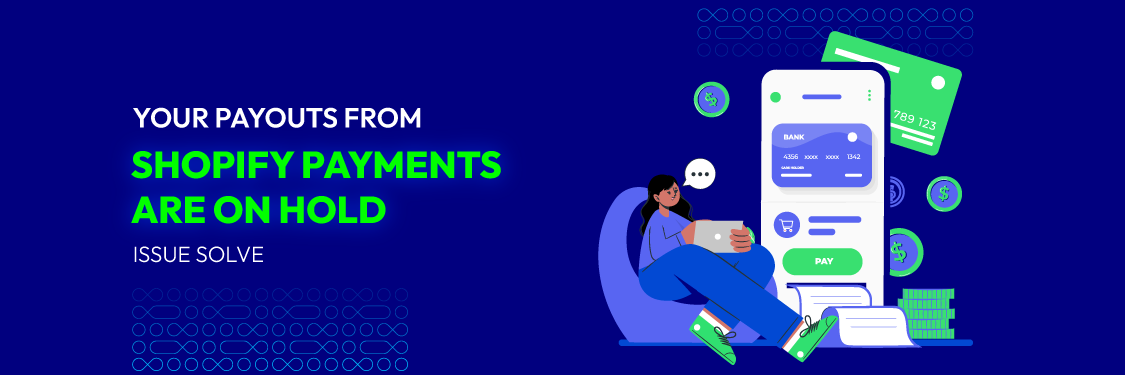“Your Payouts From Shopify Payments Are On Hold”: Issue Solved
Summer Nguyen | 04-12-2024

Are you puzzled by your Shopify Payments being put on hold? You received the message “Your Payouts From Shopify Payments Are On Hold”? You’re not alone! In this blog, we dive into the why and how of Shopify Payments holds, offering clear insights and actionable steps to swiftly get your payouts back on track.
Whether you’re a seasoned e-commerce veteran or new to the digital marketplace, understanding these holds is crucial for maintaining a smooth financial flow. Let’s unravel this mystery together and keep your business thriving!
What Are Payment Holds in Shopify Payments?
Payment holds in Shopify Payments occur when Shopify temporarily freezes the disbursement of funds from sales to a merchant’s account. This can happen for various reasons and usually involves the need for additional verification or review of certain transactions or account activities.
Payment holds are security measures that Shopify implements to safeguard both the merchant and the customers. These holds are typically put in place to verify the legitimacy of certain transactions or to ensure compliance with Shopify’s policies and financial regulations. Here are some key things to know about Shopify payment holds:
- Duration – Funds are typically held for up to 7 days for card payments and up to 30 days for bank payments like eCheck. This allows enough time for the transaction to fully clear from the customer’s end.
- Release – After the hold period, the payment will automatically be released into your Shopify account balance, minus any Shopify transaction fees. You can then withdraw the funds or use them to cover Shopify costs.
- Customization – In some cases, you can shorten the length of payment holds by having a longstanding Shopify account in good standing. Established low-risk businesses may customize hold periods.
- Communication – It’s important to communicate payment hold policies and durations to your customers in advanced to set clear purchase expectations. This improves transparency.
Identifying the Signs of a Payment Hold
Identifying a payment hold in Shopify Payments is crucial for merchants to quickly address any issues and maintain their cash flow. Here are the key signs that indicate a payment hold and how to confirm it:
Delayed Payouts
The most obvious sign of a payment hold is when expected payouts from sales are not deposited into your bank account on the scheduled date. Shopify usually follows a consistent payout schedule, so any delay can be a signal of a hold.
Notifications from Shopify
Shopify typically sends an email or dashboard notification to the merchant when a payment hold is placed. The message you may receive is “Your Payouts From Shopify Payments Are On Hold”. This communication often includes the reason for the hold and any required actions from the merchant’s side.
Checking the Shopify Dashboard
- Log into your Shopify admin account.
- Navigate to the ‘Payments’ section.
- Look for any alerts or messages indicating a hold. This section should display your payout status and any recent changes to your account that might affect payments.
Reviewing Account Status
- In your Shopify admin, review your account status for any flags or warnings.
- Check for messages related to account verification, banking information, or compliance issues.
Increased Customer Inquiries or Complaints
Pay attention to an uptick in customer inquiries or complaints regarding delayed shipments or order processing. These can sometimes precede or coincide with a payment hold if they are related to fulfillment issues.
Sudden Account Restrictions
Look for any sudden restrictions or limitations in your Shopify admin area, such as limitations on adding new products, making changes to your site, or processing orders.
Common Reasons for Payment Holds
Payment holds in Shopify Payments can occur for several reasons, each typically related to the risk management and security protocols of Shopify. Understanding these common reasons can help merchants address and potentially prevent future holds. Here are some of the most frequent causes:
- Unusual Sales Activity: A sudden spike in sales or an unusually high order value can trigger a hold. Shopify’s system may flag this as potential fraudulent activity, requiring further review to ensure the legitimacy of the transactions.
- Chargebacks and Disputes: High rates of chargebacks or disputes from customers can result in holds. This is because a high frequency of such issues could indicate problems with the products or services being offered, or potential fraudulent activity.
- Verification Issues: If there are issues verifying the merchant’s identity or business information, Shopify might place a hold. This includes incomplete or inconsistent information in the merchant’s account profile.
- Compliance with Legal Requirements: Non-compliance with legal requirements, such as anti-money laundering laws or international trade regulations, can lead to payment holds. Shopify needs to ensure all merchants comply with these laws.
- Suspicious Transactions: Transactions that appear suspicious, such as those significantly deviating from a merchant’s typical sales pattern or flagged by fraud detection systems, can cause holds. This is part of Shopify’s efforts to prevent fraudulent activities.
- Quality and Delivery Complaints: If customers frequently report not receiving items or raise concerns about the quality of the products, Shopify may place holds to investigate these claims.
- High Risk Products or Services: Selling products or services that are considered high-risk (like electronics, gift cards, or certain digital products) can result in increased scrutiny and potential payment holds.
Understanding these reasons is essential for merchants using Shopify Payments. By recognizing what triggers payment holds, merchants can take proactive steps to ensure their business practices align with Shopify’s requirements, thereby minimizing the risk of payment holds.
Steps to Resolve Payment Holds
Understand the Reason for the Hold
- Refer to the notification from Shopify or check your Shopify dashboard to understand why the hold was placed.
- Common reasons include verification needs, unusual activity, compliance issues, or chargebacks.
Gather Necessary Information and Documents
- Prepare any requested documents or information. This might include proof of identity, business licenses, invoices, proof of inventory, or transaction records.
- Ensure all documents are current, clear, and relevant to the issue at hand.
Respond Promptly to Shopify’s Inquiries
- If Shopify has reached out for information or clarification, respond as quickly and thoroughly as possible.
- Provide detailed explanations if asked about specific transactions or business activities.
Review and Update Your Account Details
- Double-check your account details in Shopify, especially your banking and contact information, to ensure everything is accurate and up-to-date.
- Correct any discrepancies or outdated information immediately.
Contact Shopify Support
- If the reason for the hold is unclear or you need further assistance, contact Shopify’s support team.
- Be ready to discuss your case in detail and cooperate fully with their requests.
Implement Compliance Measures
If the hold is due to non-compliance with Shopify’s policies or legal regulations, take steps to rectify the issue. This may involve changing how certain products are sold or updating your business practices.
Address Chargebacks and Disputes
For holds related to chargebacks or disputes, review the cases and respond appropriately. Provide evidence to support your position if necessary. Work on improving customer service and product quality to reduce future incidents.
Monitor Your Email and Shopify Dashboard
Regularly check your email and Shopify dashboard for updates on the status of the hold and any further requests from Shopify.
Preventive Measures to Avoid Future Holds
Taking preventive measures to avoid future payment holds in Shopify Payments is crucial for smooth business operations. By addressing potential issues proactively, merchants can minimize the risk of encountering holds. Here are some strategies you may consider:
Maintain Accurate and Complete Account Information
- Regularly update your Shopify account details, ensuring that all information, including contact and banking details, is current and accurate.
- Verify your identity and provide any required documentation promptly when requested.
Understand and Comply with Shopify’s Policies
- Familiarize yourself with Shopify’s terms of service, including policies related to payment processing, prohibited items, and customer interactions.
- Stay updated on any changes to these policies.
Implement Robust Fraud Prevention Measures
- Use Shopify’s built-in fraud analysis tools to identify and mitigate fraudulent transactions.
- Consider additional third-party fraud prevention services if your business is at a higher risk.
Monitor Transaction Patterns and Resolve Alerts Quickly
- Keep an eye on your sales and transaction patterns for any unusual activity and investigate any anomalies promptly.
- Address any fraud alerts or warnings from Shopify immediately.
Provide Excellent Customer Service
- Respond to customer inquiries and complaints quickly and effectively to prevent disputes and chargebacks.
- Ensure your return and refund policies are clear and customer-friendly.
Ensure Product Quality and Reliable Delivery
- Maintain high standards for product quality and ensure reliable, timely delivery to reduce customer complaints and disputes.
- Use trackable shipping methods to provide proof of delivery.
Keep Detailed Records
- Maintain comprehensive records of sales, inventory, and customer interactions.
- Be prepared to provide evidence of transactions, such as invoices or proof of shipment, if requested by Shopify.
Stay Informed About Legal and Financial Regulations
- Keep abreast of relevant legal and financial regulations that may affect your business, particularly if you sell internationally.
- Ensure compliance with anti-money laundering laws and other financial regulations.
Regularly Review Your Sales and Financial Health
- Periodically review your business’s financial health and sales patterns to identify potential risks or areas for improvement.
- Adjust your business practices as needed to maintain a healthy, sustainable operation.
Navigating Financial Uncertainties During Holds
Navigating financial uncertainties during payment holds in Shopify Payments requires strategic planning and proactive management. These holds can impact cash flow, making it important for merchants to have contingency plans in place.
Here are some tips for navigating financials when payment holds occur:
- Plan for a regular volume of holds – Assume a small percentage of payments will hit common 1-2 week holds and factor that into cash outlooks.
- Create a merchant cash reserve – Have a cash buffer earmarked specifically for operating expenses during periods of elevated holds.
- Pursue a short-term financing option – Explore overdraft coverage, line of credit, merchant cash advance or Shopify Capital to access fast funds.
- Adjust procurement & inventory – If holds cramp ability to purchase new inventory, delay orders or listing new items until payments normalize.
- Watch expense ratios carefully – With lower cash during holds, ensure expenses like payroll, marketing, or shipping don’t balloon as percentage of sales.
- Use available sales reports – Run sales, profit, and cash flow reports to identify dips related to unusual payment hold spikes rather than broader revenue problems.
- Keep customers informed on impacts – Directly communicate how holds may be affecting things like support response times, shipping lags, or product availability.
With the right mitigation plans, payment holds don’t need to critically disrupt cash levels. But they do require active monitoring and management.
Conclusion
Navigating the complexities of payment holds in Shopify Payments is an essential skill for any merchant operating in the digital marketplace. While such holds can be unexpected and somewhat disruptive, understanding the why and how behind them empowers you to address these challenges effectively. By being aware of the signs of payment holds, comprehending the common reasons behind them, and taking proactive steps to resolve and prevent future holds, you can maintain a steady financial flow and keep your business thriving.
Remember, key to managing payment holds is a combination of vigilance, clear communication, and strategic financial planning. Regularly updating your account information, complying with Shopify’s policies, providing excellent customer service, and maintaining transparent communication with your customers and Shopify support are crucial. Additionally, preparing for financial uncertainties by having contingency plans, such as a cash reserve or alternative funding options, ensures that your business remains resilient in the face of such challenges.






![Top 20+ Must-have Shopify Apps for 2025 [Free & Paid] - Mageplaza](https://cdn2.mageplaza.com/media/blog/must-have-shopify-apps/top-must-have-shopify-apps.png)
![[2025 Updates] Top 10+ Upsell Apps for Shopify - Mageplaza](https://cdn2.mageplaza.com/media/blog/best-upsell-shopify-app/cover.png)